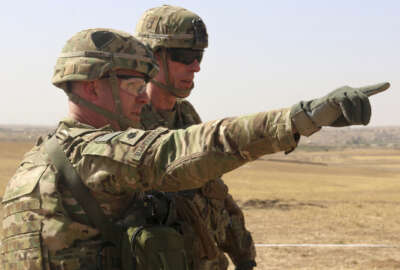Ten days after the Defense Department’s nondeployability policy went into effect, members of the nation’s largest military service are still waiting for guidance on how the Army will deal with those who are unable to deploy for a year or more.
The policy affects about 62,000 soldiers in the active Army, National Guard and reserve.
While DoD announced its policy in February, it asked each service to come out with their own guidance in relieving troops who are not able to deploy for 12 months or more.
Army Deputy Chief of Staff Lt. Gen. Thomas Seamands told reporters Wednesday at the Association of the United States Army conference in Washington that the basics will be what most people expect.
“Essentially what it will say is you have to be deployable to be able to serve in our Army,” Seamands said. “Deployability will be a condition of employment. If you can’t be deployable, we will have to take a hard look at the soldiers who are nondeployable and make honest, unemotional decisions on where they can contribute. And if they can’t contribute, we need to make sure they have the right skills as they transfer through the disability system to be a soldier for life.”
Definition of ‘nondeployable’ remains uncertain
How the process will actually work, what considerations will be taken into account, how quickly the process will happen, or even the definition of “nondeployable” are all up in the air at this point.
Seamands said the policy is currently going back and forth between the Army secretary and the Army chief of staff. The policy is expected to come out in the next couple of weeks.
“It’s pre-decisional right now. We are having discussions on what ‘right’ looks like. We don’t want to jump into it too quick and get it wrong, so we are being deliberate in our approach. We want to make sure every decision we make has a couple things in mind: the individual soldier and also the impact on readiness across the units and formations,” Seamands said.
DoD estimated there are about 126,000 nondeployable troops as of Aug. 31, but said not all will be losing their jobs.
“This is always rolling. People always become injured or nondeployable for an administrative or legal reason, and then they become deployable again,” said Patricia Mulcahy, DoD’s director of officer and enlisted personnel management.
However, the 62,000 soldiers currently nondeployable in the Army’s total force are mostly long-term cases, Seamands said. That figure makes up half of the Pentagon’s estimate and makes the soldiers possibly susceptible to the new policy.
The Army already gave commanders more discretion on deciding what is and is not deployable, which led to most of those 62,000 being long-term cases. The service gave commanders the ability to call soldiers with simple deployability violations, like lapsed dental exams, still fit for service as long as the violations were fixed before deployment. That gave the Army a clearer picture of the actual problem.
The Air Force, like the Army, has yet to release its policy, but estimated about 1,600 airmen will lose their jobs.
The Navy released its guidance for the policy on Oct. 1.
“It is the personal responsibility of every sailor to maintain individual readiness, including medical, dental, physical and administrative (e.g., maintaining a family care plan) readiness. Medical deployability will be considered during each healthcare encounter,” the Navy policy states.
Sailors who have been nondeployable for 12 consecutive months will be notified for mandatory processing for separation, or referred to the military evaluation system.
Gen. Glenn Walters, then- Marine Corps assistant commandant, said in March less than 0.5 percent of the Marine total force is “truly nondeployable.”
“About 1,000 [nondeployable Marines], that’s about what we’ve been seeing for a long time. When do I get worried about it? As soon as non-deployable status in the Marine Corps affects our ability to meet our staffing goals both on the supporting establishment side and the operational side,” Walters said.
The purpose of the policy is to increase the lethality of the force, Mulcahy said.
She added that the purpose is not to push people out of the military, but rather to emphasize getting troops to deployable status. That may include moving medical centers closer to bases or focusing more on sports medicine.
“The situation we face today is really unlike anything we have faced, certainly in the post-World War II era,” then-Undersecretary of Defense for Personnel and Readiness Robert Wilkie said during a February Senate hearing. “If Mr. [Jeff] Bezos at Amazon walked into Christmas week and 14 percent of his workforce could not perform their duties, then [it] would no longer be the largest company in the world.”
Copyright
© 2024 Federal News Network. All rights reserved. This website is not intended for users located within the European Economic Area.

